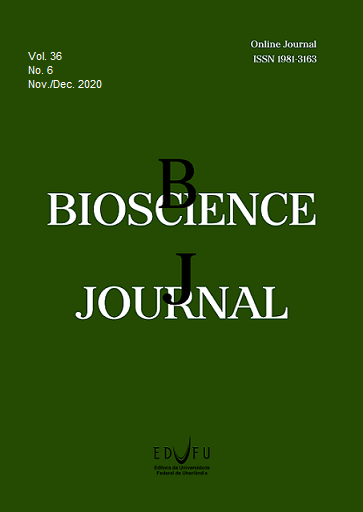Doses, methods and times of application of boron in soybean under field conditions
DOI:
https://doi.org/10.14393/BJ-v36n6a2020-48015Keywords:
Glycine max., Micronutrient., Boric acid., Foliar fertilization.Abstract
The boron (B) fertilization in soybean is important to ensure great yields. Boron correction must be applied in deficient soils repairing losses, exports and leaching. The objective of this study was to evaluate the effects of doses, methods and times of application of B in soybean B content and yield. The field experiments were conducted during the 2015/16 and 2016/17 cropping seasons and set as a randomized block design with nine treatments (0, 0.5, 1, 1.5, 2 kg ha-1 of B, 0.5 kg ha-1 of B mixed with NPK (02-28-18) in furrow during sowing, foliar application with 0.3 kg ha-1 of B in V4 soybean stage, foliar application with 0.3 kg ha-1 of B in R1 soybean stage, and foliar application of 0.15 kg ha-1 in V4 plus 0.15 kg ha-1 of B in R1 soybean stage) and four replications. Boric acid was the B source and the variables analyzed were: B leaf content, B exported in seeds, number of pods per plant, number of seeds per pod, weight of 100 seeds (g) and productivity (kg ha-1). The levels of B in leaf were between 30.1 and 43.8 mg kg-1 and between 65.0 and 92.6 mg kg-1 in the 2015/16 and 2016/17 growing season, respectively. Exports of B in seeds were estimated between 166 and 248 g ha-1 and between 208.9 to 260.8 g ha-1 in the 2015/16 and 2016/17 growing season, respectively. Great productivity (3,820 kg ha-1) was observed in the 2016/17 growing season, with an estimated dose of 0.95 kg ha-1 of B.
Downloads
Downloads
Published
How to Cite
Issue
Section
License
Copyright (c) 2020 Renan Cesar Dias da Silva, Geovani Soares da Silva Junior, Adilson Pelá, Regina Maria Quintão Lana, José Geraldo Mageste da Silva

This work is licensed under a Creative Commons Attribution 4.0 International License.





